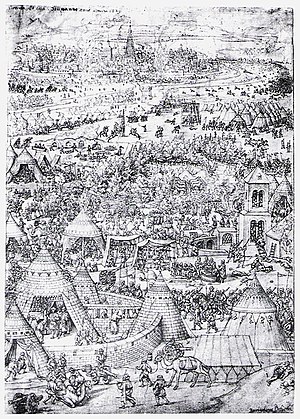การล้อมกรุงเวียนนา
การปิดล้อมกรุงเวียนนา (อังกฤษ: Siege of Vienna; 27 กันยายน-14 ตุลาคม ค.ศ. 1529) การปิดล้อมกรุงเวียนนาในปี ค.ศ. 1529 เป็นความพยายามครั้งแรกโดยจักรวรรดิออตโตมันที่นำโดยสุลต่านสุลัยมาน เพื่อที่จะยึดกรุงเวียนนาในออสเตรีย การปิดล้อมเมืองครั้งนี้ถือเป็นสัญญาณบ่งบอกถึงอำนาจของจักรวรรดิออตโตมันซึ่งกำลังขยายถึงจุดสูงสุด ซึ่งมีอาณาเขตขยายมาจนถึงบริเวณยุโรปกลาง หลังจากนั้นความเป็นปฏิปักษ์ต่อกันก็ยืดเยื้อยาวนานออกไปกว่า 150 ปี และในที่สุดจึงกลายเป็นยุทธการเวียนนาใน ค.ศ. 1683 ซึ่งเป็นการเริ่มมหาสงครามตุรกี (Great Turkish War) โดยมหาอำนาจยุโรปในการพยายามกำจัดออตโตมันออกจากยุโรปกลาง การล้อมครั้งนี้จบลงด้วยความล้มเหลวของฝ่ายออตโตมันในการพยายามยึดที่มั่นสำคัญของจักรวรรดิโรมันอันศักดิ์สิทธิ์ในขณะนั้น และเป็นจุดเปลี่ยนทิศทางของชัยชนะในยุโรปตะวันออกและยุโรปกลางของจักรวรรดิออตโตมันที่ได้รับชัยชนะมาตลอดก่อนหน้านั้น ซึ่งรวมถึงการได้ฮังการีตะวันออกเฉียงใต้ มาเป็นอาณาจักรในบริวารในยุทธการโมเฮ็คส์ (Battle of Mohács)
| การปิดล้อมกรุงเวียนนา | |||||||
|---|---|---|---|---|---|---|---|
| ส่วนหนึ่งของ สงครามออตโตมันในยุโรป และ สงครามออตโตมัน-ฮับส์บวร์ก | |||||||
 ภาพพิมพ์แสดงการต่อสู้ระหว่างออสเตรียและออตโตมันนอกกรุงเวียนนาในปี ค.ศ. 1529 | |||||||
| |||||||
| คู่สงคราม | |||||||
|
พร้อมด้วยเช็ก, เยอรมัน สเปน และ ทหารรับจ้าง |
เซิร์บ | ||||||
| ผู้บังคับบัญชาและผู้นำ | |||||||
| นิคลาส กราฟ ซาล์ม |
สุลต่านสุลัยมาน ปาร์กาลิ อิบราฮิม ปาชา (อัครเสนาบดี) | ||||||
| กำลัง | |||||||
| ปีนใหญ่ราว 120กระบอก ทหารราว 23,000 คน[2] | ปีนใหญ่ราว 300กระบอก ทหารราว 120,000 คน[3] | ||||||
| ความสูญเสีย | |||||||
| ไม่ทราบจำนวนแต่สันนิษฐานว่าพลเรือนเสียชีวิตเป็นจำนวนมาก[4] | 15,000 คน[5] | ||||||
เหตุการณ์ครั้งนี้มักกล่าวกันว่าเป็นจุดที่เริ่มนำความตกต่ำมาสู่จักรวรรดิออตโตมันที่ครั้งหนึ่งเคยเป็นมหาอำนาจทางการทหารทั้งในยุโรปและเอเชีย และเป็นการพ่ายแพ้ทำความอัปยศให้แก่ออตโตมันในการมาพ่ายแพ้ต่อกองกำลังที่เล็กกว่าและมีประสิทธิภาพด้อยกว่า[6]
นักประวัติศาสตร์บางท่านสันนิษฐานว่าจุดประสงค์หลักของสุลต่านสุลัยมานในการล้อมกรุงเวียนนาในปี ค.ศ. 1529 เป็นการแสดงอำนาจเหนือฮังการี เพราะด้านตะวันตกของฮังการีที่เรียกว่ารอยัลฮังการีที่ยังดำรงความเป็นอิสระจากออตโตมันอยู่ นอกจากนั้นการตัดสินใจเข้าโจมตีเวียนนาหลังจากการยุติการรณรงค์ในยุโรปของออตโตมันไปเป็นเวลานานทำให้คาดกันว่าเป็นการโจมตีแบบฉวยโอกาสหลังจากที่ได้รับชัยชนะอย่างเด็ดขาดในฮังการี ส่วนนักวิชาการผู้อื่นก็ตั้งทฤษฎีว่าการปราบปรามฮังการีเป็นเพียงบทนำของการเริ่มการเข้ามารุกรานยุโรปตามที่ได้วางแผนไว้ก่อนหน้านั้นแล้ว[7]
อ้างอิง
แก้- ↑ Shaw, Stanford J. (29 October 1976). History of the Ottoman Empire and Modern Turkey. Cambridge University Press. p. 93. ISBN 978-0-521-29163-7. สืบค้นเมื่อ 22 September 2011.
- ↑ Turnbull says the garrison was "over 16,000 strong". The Ottoman Empire, p 50; Keegan and Wheatcroft suggest 17,000. Who's Who in Military History, p 283; Some estimates are just above 20,000, for example: "Together with Wilhelm von Roggendorf, the Marshal of Austria, Salm conducted the defense of Vienna with 16,000 regulars and 5,000 militia." Dupuy, Trevor, et al., The Encyclopedia of Military Biography, p 653.
- ↑ Turnbull suggests Suleiman had "perhaps 120,000" troops when he reached Osijek on 6 August. The Ottoman Empire, p 50; Christopher Duffy suggests "Suleiman led an army of 125,000 Turks". Siege Warfare: Fortresses in the Early Modern World 1494-1660, p 201. For higher estimates, see further note on Suleiman's troops.
- ↑ Turnbull, Stephen. The Ottoman Empire 1326 - 1699. New York: Osprey, 2003.pg 51
- ↑ Turnbull, Stephen. The Ottoman Empire 1326 - 1699. New York: Osprey, 2003. pg 51
- ↑ "The failure of the first [siege of Vienna] brought to a standstill the tide of Ottoman conquest which had been flooding up the Danube Valley for a century past." Toynbee, p 119; "The expedition had been successful at least politically. Suleiman had driven Ferdinand out of Hungary and installed in his place an obedient vassal. But more significant was the fact that a Turkish army had been beaten back before the walls of Vienna by a force much inferior in numbers. This may be considered the beginning of the end of Ottoman military superiority…at Vienna Suleiman discovered that western artillery was equal to his own and that Austrian and Spanish foot soldiers with their harquebuses and long pikes, were, if anything, superior to his janissaries." Stavrianos, p 77; "Sitting outside the Habsburg capital, with his army beset by seemingly insurmountable logistical problems, Suleiman was brought to conclude that the Ottoman Empire could expand no further into Europe, that Muslim expansionism in Eurasia had reached, indeed had probably extended beyond its destined territorial limits." Sicker, p 1-2.
- ↑ It was an "afterthought towards the end of a season of campaigning". Riley-Smith, p 256; "A last minute decision following a quick victory in Hungary". Shaw and Shaw, p 94; Other historians, for example Stephen Turnbull, regard the suppression of Hungary as the calculated prologue to an invasion further into Europe: "John Szapolya [sic] became a footnote in the next great Turkish advance against Europe in the most ambitious campaign of the great Sultan’s reign." Turnbull, p 50.